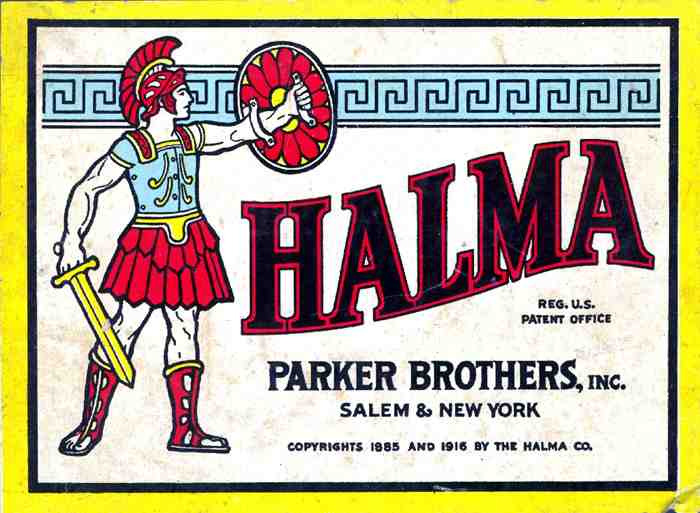|
The Rules of Halma
Object:
The object of the game is to move all one's pieces across the board and
into the opponent's starting position. If a player's pieces become
imprisoned in their starting position and cannot be moved, such player
must forfeit the game as soon as all the available points within
his/her starting position are occupied.
Set-up:
For 2 players, 19 pieces are positioned in the appropriate opposite
corners. For 4 players, 13 pieces are positioned in each corner.
To start:
Having decided who plays first, the players take turns moving a single
piece of their own colour per turn. A piece may either be moved into an
adjacent hole or it may jump over single pieces. When a jumping move is
made, each jump must be over an adjacent piece and into a vacant point
directly beyond it. Jumps may be made over pieces of any color, the
moving player's color included. Jumps may be made in any direction, and
changes of direction are allowed in multiple jumps. A player does not
have to make all possible jumps in his/her turn.
The pieces are never removed from the board. The pieces may be moved in
and out of any points on the board. However, once a piece is moved into
its goal area, it may not be moved out. Although it may be moved within
the goal area.
© 2000-2003 AbstractStrategy.com
|
For a more detailed rule set; please visit the Masters Traditional Games website |
Image from AbstractStrategy.com |
The Rules of Chinese Checkers
Object
of the game:
The object of Chinese Checkers is to move your marbles across the board
to the star point directly opposite your starting star point.
To Play the Game:
Each player uses a different colored set of marbles and places them
into the holes in one point of the star. The players may move or jump
in any direction as long as they follow the lines. The marbles may move
one hole or jump one marble of any color in any direction, provided the
hole beyond the jumped marble is vacant. Multiple jumps are allowed
wherever they can be made following the rules. Play continues to the
left.
(The following rule is not part of the original rules of
the game.)
If one or more of a player's marbles are imprisoned in his/her original
starting point so that the marbles cannot be moved, such player
forfeits the game. In the event of multiple players, the imprisoned
marbles are removed and the game continues as before.
© 2000-2003 AbstractStrategy.com
|
For a more detailed rule set; please visit the Masters Traditional Games website
|
Image from AbstractStrategy.com |
![]()
Note:
"What is unique about HALMA, CHINESE CHECKERS,...., is that the game play consists of jumping pieces--your opponents and your own--without removing the jumped pieces from the board; moves to adjacent spaces without a jump are also allowed." (Bruce Whitehill)
![]()
Strategy guide (from WikiBooks Chinese Checkers strategy guide) by Darren A. Chilton
 Opening Moves
Opening MovesKnowledge of openings is very important to playing Chinese Checkers well -- similar to chess. In play among experienced players there are only a few openings that are commonly seen. Although there are 14 possible first moves (7 if you eliminate symmetrical moves for the first player), experienced players play only two.
By far the most common first move is to move one of the two marbles on either end of front row of the four forward marbles one space forward and towards the center (as illustrated by green in the picture). This is the first move of the two most common openings the "sidewinder" and "cross caterpillar", there are many other less common openings.
A much less common first move sometimes played by advanced players is to move one of the marbles in the front row one space forward and away from the centerline (the red marbles in the picture nearby show these moves). This first move leads into "Squad's opening" and other similar openings.
General hints
Get as far as possible
One of the most basic strategies of the game is, of course, to get as far as possible. However, during play, it is not always the best move to go to the very end of a jump; sometimes you have to block your opponent. Although they may not like this, it is a real advantage to block them. Of course if you imagine a computer player, they will do this automatically if they think one extra move ahead!
Keep moves near a center line
If you split up your pieces at the wrong moment you'll find that you will be left with a lonesome piece that will
 take you a lot of wasted moves to get to the end. Also, there are always more pieces in the center line than near the edges. So keeping your pieces near the center line is an important advantage as you can always move your pieces.
take you a lot of wasted moves to get to the end. Also, there are always more pieces in the center line than near the edges. So keeping your pieces near the center line is an important advantage as you can always move your pieces.Get into the goal area
If you have your pieces inside the goal area, it is also easier to feed following pieces in. The two outer edges seem to be more of an advantage. Often you may shuffle the pieces inside the goal to get more in, but don't overdo it; you have to get the external pieces in the shortest number of moves.
The piece furthest away from goal
This is a major help in play. You should always check your last piece because it can quite rapidly become stranded and you will lose the game. Basically, before making a move always check if you can get the last piece up.
What is the shortest possible game of Chinese Checkers?
In 1979, David Fabian found a complete game of two-person Chinese Checkers in 30 moves (15 by each player) [Martin Gardner, Penrose Tiles to Trapdoor Ciphers, MAA, 1997]. This solution requires that the two players cooperate to generate a win as quickly as possible for one of them. The 15-move game begins with 10 men on each side.Gardner also talks about the fastest way to transport one set of 10 men to the opposite side of the board (a 1 player version of the game) and gives a solution in 27 moves. This solitaire version was found by Octave Levenspiel in 1971.
George I. Bell has published a paper where he proves these findings mathematically and by help of a computer game:
INTEGERS: ELECTRONIC JOURNAL OF COMBINATORIAL NUMBER THEORY 9 (2009), #G01: SHORTEST GAME OF CHINESE CHECKERS AND RELATED PROBLEMS (PDF)
|
© 2004 - 2011 Vegard Krog Petersen |
Home
History
Rules
Variations
Online
Freeware
Trialware
About
Links

 Chinese Checkers
Chinese Checkers

